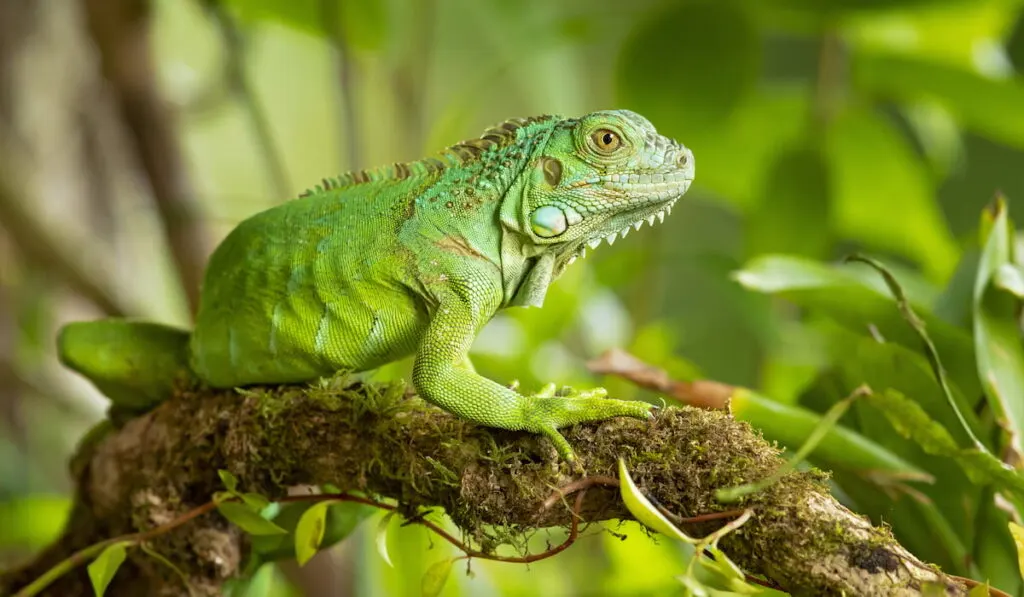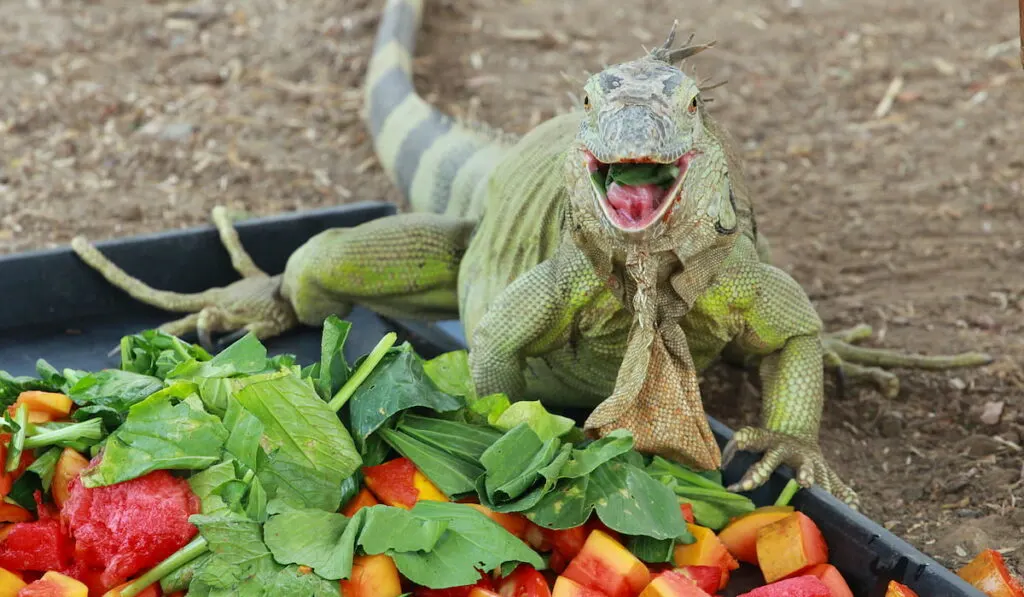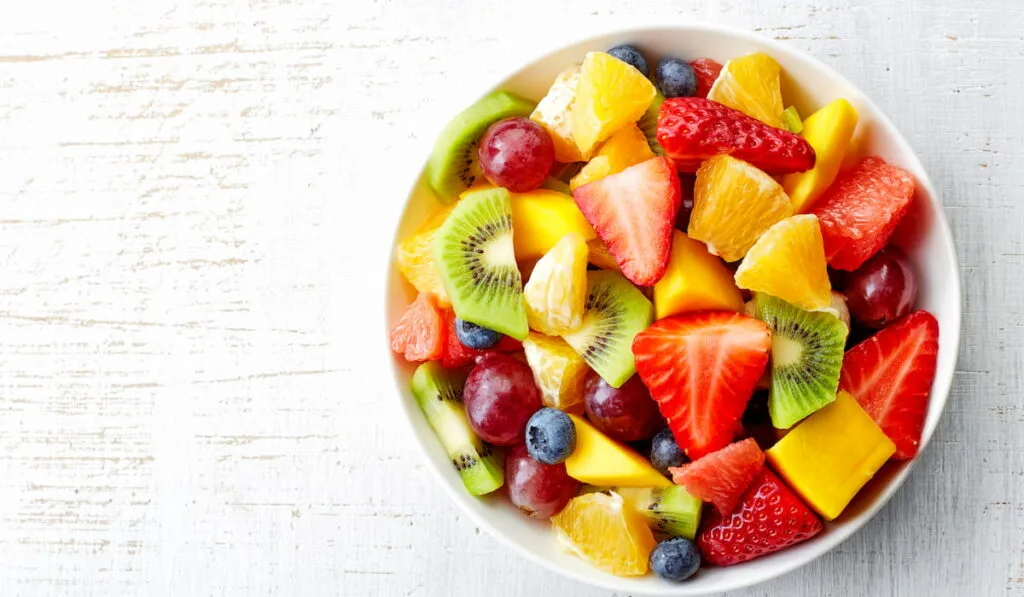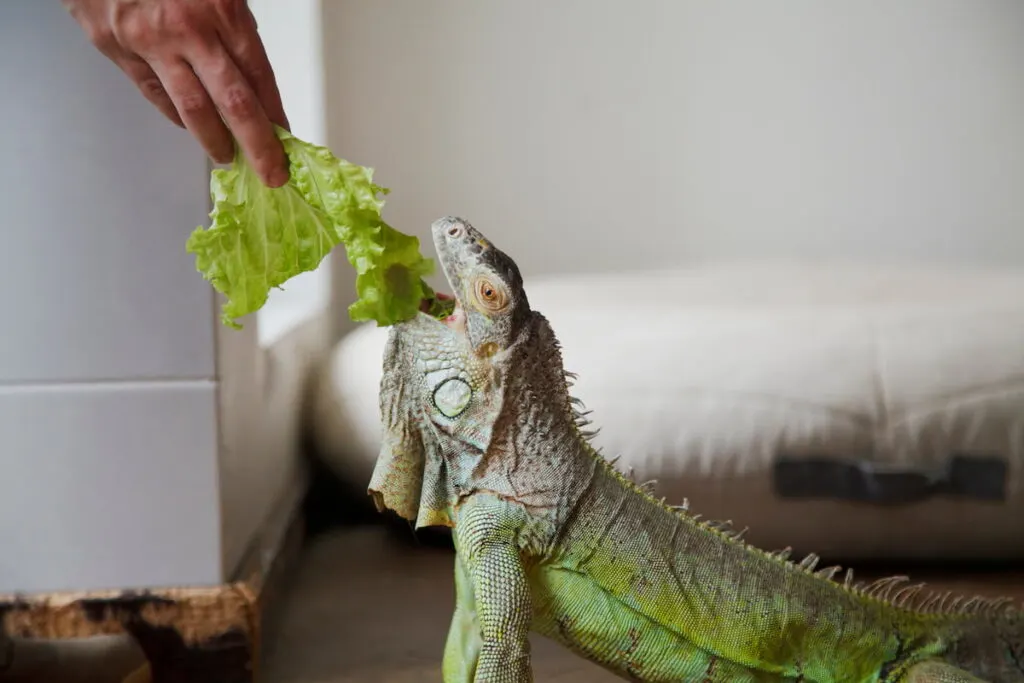Iguanas have been quite popular pets for a long time. If you go to a pet store, you are likely to see baby iguanas ready to purchase. Compared to other lizards, they are often relatively inexpensive. When people buy iguanas, they are often drawn to the cute baby lizards and don’t always think through the amount of care needed to ensure they have a long and healthy life.
What do iguanas eat? Iguanas require a large variety of vegetables and fruits as well as some vitamin supplements to maintain their health. However, you can’t assume that all iguanas eat the same thing. There are several different types of iguanas, and each has vastly different nutritional requirements.

Once you take your baby iguana home, you are the person responsible for keeping the iguana healthy. To do this, you need to research to determine the exact nutritional needs of your iguana type.
If you fail to feed your iguana appropriately, it could quickly fall ill. In this article, you will learn the details of an iguana’s diet, the supplements they need to take, and much more!
Table of Contents
Feeding Your Iguana
It is important to remember that all iguanas are herbivores. This means that they depend on plants for all their nutritional needs. When an iguana is in nature, its food sources will be much different than the sources available in captivity.
When you are feeding your iguana, you must remember the rule of feeding 80%-90% dark leafy greens and 10%-20% fruits. Fruit has a very high fiber content, so you must make sure it isn’t a large part of the iguana’s diet. If an iguana eats too much fruit, it can become ill.
Best Vegetables for Iguanas
It may be tempting to head to the store and just purchase any vegetables you come across on your trip, but you cannot choose random vegetables for your iguana. It is essential to focus on variety and dark leafy greens. Many good choices can be made when purchasing vegetables.

According to The VCA Hospital, some iguana-friendly vegetables that you can use for high-volume feeding are:
- Collard greens
- Turnip greens
- Alfalfa
- Dandelion
- Swiss Chard
- Mustard greens
- Broccoli
- Hay
- Bok Choy
- Kale
- Dandelions
- Kohl Rabi
- Bell peppers
- Beet greens
This list is not an exclusive list of iguana friendly vegetables, but they are likely the most readily available at the local supermarket. When feeding vegetables, you will notice that some plants and vegetables can be fed to your iguana often, and others cannot.
Some iguana-friendly vegetables for low-volume feeding are:
- Cactus
- Squash
- Sprouts
- Cooked sweet potato
- Parsnips
- Corn
- Peas
- Carrots
- Okra
- Asparagus
- Cucumber
- Mushrooms
While all the vegetables listed above are healthy for your iguana to consume, they may not be overly thrilled with some of the choices. Just like any animal, you need to see what your iguana prefers and go from there.
Best Fruits for Iguanas
Remember, fruit should not make up a large portion of an iguana’s diet. However, some fruit is okay on occasion. Some iguana owners provide fruit as a treat or a topping to the food they have prepared for their pet. Although they are nutritious, fruits don’t offer the best source of nutrients for iguanas.

If you want to provide fruits for treats or topping purposes, here are some excellent iguana-friendly fruit options:
- Raspberries
- Strawberries
- Pears
- Apples
- Raisins
- Grapes
- Melons – any kind
- Bananas (with skin)
- Star fruits
- Mangos
- Peaches
- Tomatoes
- Kiwis
When deciding which fruit to give your iguana, you may find they are not fond of some of them. If you notice the iguana isn’t interested, keep trying until you see the iguana enjoying the fruit.
You mustn’t overfeed an iguana fruit. Too much fruit can cause the iguana to have diarrhea, which can be life-threatening.
Treats for Iguanas
Iguanas are like any other animal, and they like treats. You won’t likely be able to train your iguana to beg or work for treats, but regardless, they want treats. It is important to remember that not all treats are created equal.

Some of the better treat options for iguanas are:
- geraniums
- carnations
- dandelions
- hibiscus
- nasturtium
- roses
If you choose to provide your iguana with flowers as treats, you must be well researched before purchasing the flowers. Most flowers have been chemically treated. These chemicals can be harmful to the iguana and should, therefore, not be ingested.
Where to Get Flowers
There are many places you can get flowers for your iguana to eat, but you need to be cautious with the chemical treatment they may have been exposed to.
The best and safest place to go would be to a local florist. They will be able to tell you how the flowers have been grown as well as how they have been taken care of.
Many florists throw away flowers that have begun to wilt. You may be able to get these for free if you ask for them.
Where Should I Purchase Food for My Iguana?
When it comes to purchasing fruits and vegetables for your iguana, you want to use careful consideration regarding the quality. Sure, you may be able to score a great deal at a big box store, but it may not be as healthy as it could be for your iguana.
It is best to stick with organic produce when purchasing food for your iguana, however, this may not fit into every budget. You can buy other produce at the store, but you want to spend extra time washing it before you give it to your pet.
Many farms use pesticides and chemicals on their crops. Although the produce may not have been sprayed directly, their leaves tend to hold onto residue, which could be harmful to your iguana.
Do I Need to Give My Iguana Vitamins?
As lovely as it would be for your iguana to get every dietary need met by fruits and vegetables alone, it won’t likely happen. The food you choose is nutrient-dense, but your iguana will probably need to take vitamins to ensure they remain healthy.
One of the most common nutrients that needs to be supplemented is calcium. Calcium serves an iguana the same way it does a human. It helps provide strong bones. It also allows iguanas to lay strong shelled eggs.
How do I Supplement Calcium?
If you have ever been to a pet store in person or online, you will likely feel highly overwhelmed with all the choices and decisions. Finding calcium for your iguana may make you feel the same. There are many brands and types of calcium to choose from. It is best to stick with a powdered option that you can easily sprinkle over the iguana’s food.
To provide extra calcium to your iguana, you will use the recommended amount based on the brand you choose. The calcium powder gets sprinkled on top of your iguana’s food 2-3 times a week. Be sure only to sprinkle the food the iguana will be consuming. Sprinkling too much food at once can lead to lost nutrients, as the food will likely be thrown away at the end of the day.
Top Brands of Calcium Supplements
Shopping for the “best” supplement can be a daunting task. Here are two calcium supplements that are great for iguanas:
- Zoo Med Repti Calcium D3 Reptile Supplement – not derived from oyster shells
- Flukers Repti Calcium
Both of these options are highly rated. When purchasing calcium for your iguana, you want to be sure that you are getting the correct item. There are many forms of calcium that are fortified with other minerals and nutrients. Your iguana may not need the other nutrients to maintain their health.
Important Note: If you or anyone that will be handling the iguana has a shellfish allergy, you will want to avoid calcium supplements derived from oyster shells. Because you are sprinkling the powder over the food, it will likely get on their body. When picking the iguana up, the powder will transfer to your hands and could cause a slight allergic reaction. The severity of this reaction is dependent on the degree of your allergy.
Commercial Iguana Food
Perhaps mixing an iguana salad every day isn’t possible for you. If this is the case, you may want to explore the use of commercial iguana food. Like calcium, there are many different brands on the market. You need to choose what will work best for you and your pet.
Some top-rated iguana food brands are:
- Rep-Cal SRP00805 Adult Iguana Food, 2.5-Pound
- Zilla Juvenile Iguana Fortified Daily Diet
- Nature Zone Bites for Iguanas, Soft Moist Food, 24-Ounce
How Much Water Does an Iguana need?
An iguana must have constant access to fresh water. Each day, your iguana’s water bowl will need to be cleaned and refilled. If you don’t change the water often, harmful bacteria can begin to grow, which can make your iguana sick.
Iguanas not only drink water, but they also like to bathe or play in the water. Because they tend to submerge their entire body in the water bowl, you will want to make sure you have a water bowl that is both large enough and stable in the habitat.
When searching for proper water bowls, you will find a variety of materials that are used. Some bowls are plastic, while others are a resin material.
Some top-rated water bowls for iguanas are:
Exo Terra Water Dish
Fluker's Repta-Waterer for Reptiles and Small Animals - 16 oz
Zoo Med Reptile Water Dish
What Kind of Water Should I Use?
When preparing to give water to your iguana, you may be wondering what type of water you should use to ensure the safety of your pet. You may be tempted to go to the tap and just fill the dish. Unless you have a water conditioner hooked to your water source, this is not a good idea.
There are chemicals in tap water that can be harmful to your iguana. The best thing to do would be to get filtered or bottled water to use. One of the main chemicals found in tap water is fluoride. Fluoride is harmful to iguanas because it doesn’t allow the body to absorb calcium the way it needs to.
If you aren’t sure about the chemical content of your tap water, it would probably be best to steer clear of it and instead purchase bottled water for the iguana.

How Much do I Feed My Iguana
Iguanas will need different amounts of food, depending on their age and size. The following chart will help you as you determine your iguana’s daily needs. It is essential to remember that a baby or young iguana’s needs are going to be different than an older iguana.
| Iguana Age | Feeding Needs |
| Hatchling – 14 inches in length | Growing iguanas will need a different feeding schedule compared to their adult counterparts. They should have access to food all day long. You can choose to provide food for you iguana at regularly scheduled feeding times, as well. If you choose feeding times, there should be two. |
| Juveniles 2.5 years old 3 feet in length | Feed 1 time a day |
| Adults over 2.5 years and 3 feet in length | Feed 1 time a day |
When feeding your iguana, it is also crucial to remember that water must be available around the clock. Your iguana will thank you for this, as it will keep them healthy and entertained.
How do I Feed My Iguana?
When feeding your iguana, it isn’t as simple as throwing a chunk of leaves into the pen after they have been cleaned. Iguanas CANNOT chew. Because of this, they swallow their food whole. To help your iguana, make sure all food is cut into appropriately sized pieces.
When preparing food for your iguana, it is a good idea to mix several veggies with a fruit topping. It is like you are making a salad for your iguana to enjoy. When mealtime is over, remove the bowl and any remaining food, so it doesn’t rot in the cage.

Can My Iguana Have Protein?
There are many different answers and beliefs when it comes to feeding your iguana. Some believe you can provide limited sources of protein for your iguana with crickets and mealworms.
Iguanas are natural herbivores, so the need for animal-based protein may not be necessary. If you are unsure of what to do, it is best to seek the advice of a vet that is trained to care for reptiles. They will be able to provide guidance that is best for your iguana.
Do I Cook the Food?
You may be wondering if you must cook all the food for your iguana. You will notice the option of sweet potatoes has a note that they must be cooked. They are a very firm food, which can make digestion tough for an iguana.
When preparing food for your iguana, the rule of thumb is that raw is best. Cooked food loses some of its nutrients when being exposed to high heat, and you want to provide the most nutrient-dense food possible to maintain the health of your iguana.
Foods of Caution
Many foods can be provided for your iguana. However, there are some foods that you need to be cautioned against, not because they are unhealthy in moderation, but in excess, they can cause problems with your iguana.

The leafy greens: swiss chard, spinach, and beet greens should be provided on a limited basis. They are very iron-rich and can cause your iguana to have trouble fully absorbing calcium and other minerals from food.
If you choose to provide cabbage, kale, or mustard greens, do so sparingly. If you give an iguana an excessive amount of these leafy greens, it could cause them to have hypothyroidism.
Keep in mind, if you provide these greens in moderation, they won’t likely cause any issue with your iguana. However, if you find a great sale on spinach and decide to make that most of your iguana’s diet, you may end up with a sick iguana. Often these illnesses and effects don’t occur quickly; they occur over time. So, keep an eye on your iguana to monitor their health.
Final Thoughts
Having a pet iguana is fun and quite popular, but you need to be prepared to be a responsible iguana owner, and that comes down to the food you can provide for your pet. Although the iguana’s diet isn’t expensive, it is time-intensive and requires preparation. You need to be able to commit to providing fresh fruits and vegetables or a comparable commercial food for your iguana. If you follow the guide in this article, you will likely have a very healthy iguana that lives a long life.
Resources
When learning about iguanas and their very specific dietary needs, it is important to utilize a variety of sources. Below are the sources used for this article.
- National Geographic – The Green Iguana https://www.nationalgeographic.com/animals/reptiles/g/green-iguana/
- Untamed Science- Green Iguana by Rob Nelson https://untamedscience.com/biodiversity/green-iguana/
